Amphibians page 2---Bullfrogs!
This
page was born 04/29/2016. Rickubis designed it. (such as it
is.) Last update: 5/22/2017
Images
and contents on this page copyright © 2002-2017 Richard M. Dashnau
Here are my other Brazos Bend
and/or critter pages:
----------------------------------------------------------------
OR, FOR OTHER ANIMALS:
Alligators
at Brazos Bend State Park Introduction
Critters at Brazos
Bend State Park Page 1
Snakes-nonvenomous
1-------------------------------------------
Critters
at Brazos Bend State Park Page 3
Snakes-nonvenomous
2-------------------------------------------------Insects,
non-toxic
Snakes-nonvenomous
3------------------------------------------------Spiders
Snakes-venomous------------------------------------------------------Mammals
Birds-Waders----Birds-Raptors---------------------------------
LIZARDS!
05/07/2017 Bullfrog calling...revisited Last year, I discovered that male bullfrogs' ears are twice as large as the females' not to hear better than the females. Instead, the large ear helps increase the power
of the bullfrog's call. That is, the large ears don't help them hear better....the large ears help them sound better! Since then, I've been trying to get better video of male bullfrogs calling. I have finally captured
some video at 480 frames per second (FPS). The video clearly shows the movement of the ear membranes.


The
two images below are frame grabs from one of the video clips. The
images show one ear membrane distended, and then collapsed. The video
is at this link.


4/10/2016 Bullfrogs
have been calling in the park. I'm a little ashamed to say that up
until now, I'd never considered taking a close look at what they are
actually doing. Bullfrogs are usually a bit shy, and tend to call
from
cover--or, they'll stop calling and jump away before they can be seen.
For the last few weeks the Bullfrogs have been calling along the
Spillway Trail, and have been easy to see in the corner of Pilant Lake
near
the Elm Lake water station. With all that "talking" going on,
I was able to get a very good short video clip of a bullfrog calling,
along with that odd "poot" sound that they sometimes make. I wondered
about that sound,
and scanned the Internet for some hint about how
or why it happens. I discovered some interesting things about
bullfrogs and their calls.
Bullfrogs actually make a number of
different sounds. Males usually do the calling, though females may
vocalize occasionally. The most common is called an
"advertisement call". That's the loud "Ruh AMH", or "Jug o RUM"
call.
The less-impressive "poot" noise is an "encounter call", or
"territorial sound", and is made to warn off or challenge other male
frogs that have wandered into a frog's territory. One study shows
that male frogs respond
more often to frogs calling from further
away than to those closest--possibly since they already know where the
nearest males already are, and therefore their territories. Also,in a
particular area, different frogs will start
the chorus on different
days. They sort of..."take turns". And, since calling is an
"advertisement", it draws attention to the caller--and this includes
territorial aggression by other frogs. Some male frogs avoid this
aggression
by a behavior called "satelliting". The "satellite" frogs remain quiet during the advertisement chorus, although they know where the calling males are. When a female is drawn to one of the advertisers, the "satellite" frog
intercepts and mounts it before it can get to the calling male. Pretty sneaky, eh? The study is referred to on this page. But wait...things get a bit stranger.
The
ears on male Bullfrog ears are about twice as big as the ears on female
Bullfrogs. A Bullfrog's ear can be identified by the big circles just
behind the eyes. Those circles are actually membranes (tympanic
membranes)
which work like our eardrums. Vibrations through the air
(sound) cause the membraned to vibrate, and that vibration is
transmitted internally by mechanical linkages to the organs that change
it to nervous impulses. Previously,
I'd read somewhere that the males' ears were bigger to give them better hearing during mating communication. But apparently that's not the case. In this study: ("Function of the sexually dimorphic ear of the American
bullfrog,
Rana catesbeiana:brief review and new insight", by Y. L. Werner1,*,†,
J. Pylka1,‡, H. Schneider2, M. Seifan3, W. Walkowiak2,§ and U.
Werner-Reiss4; I found it at this link) they find that although the male membrane is
larger,
there are some aspects of the anatomy of the male ears that
offsets the larger membrane size. For example there is a cartilaginous
pad in the middle of the ear where the sensor bone structure rests on
the membrane
(it's the dark center of the ear membrane).
On male frogs, this pad is thicker--which offsets any advantage from
the larger membrane surface. After experimentation, the function of the
male and female bullfrog ears was found to
be not very different
at all. So if the larger male bullfrog ear doesn't make it hear better
than the female; WHY would it be that way? How could it benefit the
male bullfrogs?
This paper may have an answer: ("Tympanic
sound radiation in the bullfrog Rana catesbeiana", by A. P.
Purgue.) The abstract is here. The experiments and results seem to show that as the frog calls, the ear membrane vibrates
and
helps add power to the call. The larger ear helps the call by adding
about 20 dB (decibels) at the "dominant frequency" of the call (about
250 Hz range) and adding about 60 dB at the high-frequency part of the
call
(about 1000 Hz). The bullfrogs may be "calling" with their
EARS! After I'd learned this, I intended to shoot more video of
bullfrogs calling (my camera has the reach) to see if I can catch this
vibration-but the park is currently
flooded. However, when I examined my video, which I shot on 4/10/16, I found that it's possible to see the vibration. The video clip is short, and I've cropped and slowed down the area of the eardrum to show it better. It looks like
it's moving! That is pretty amazing.
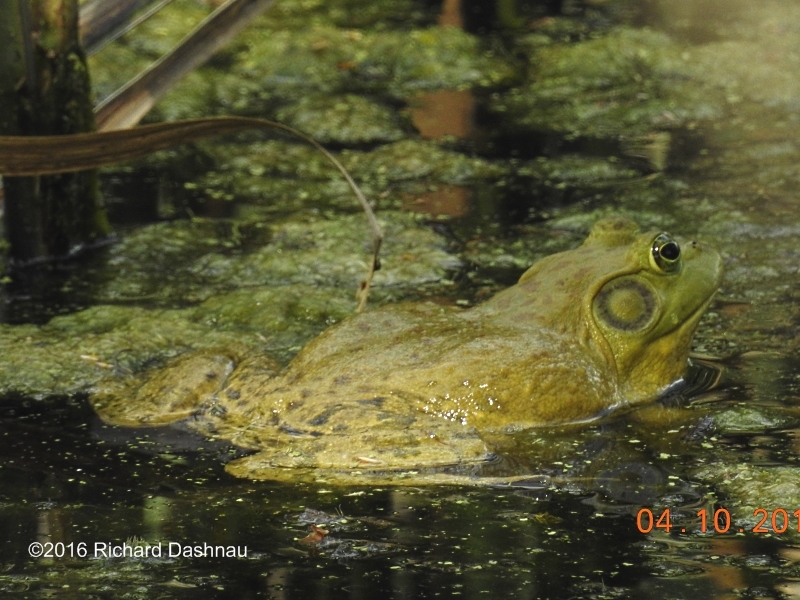
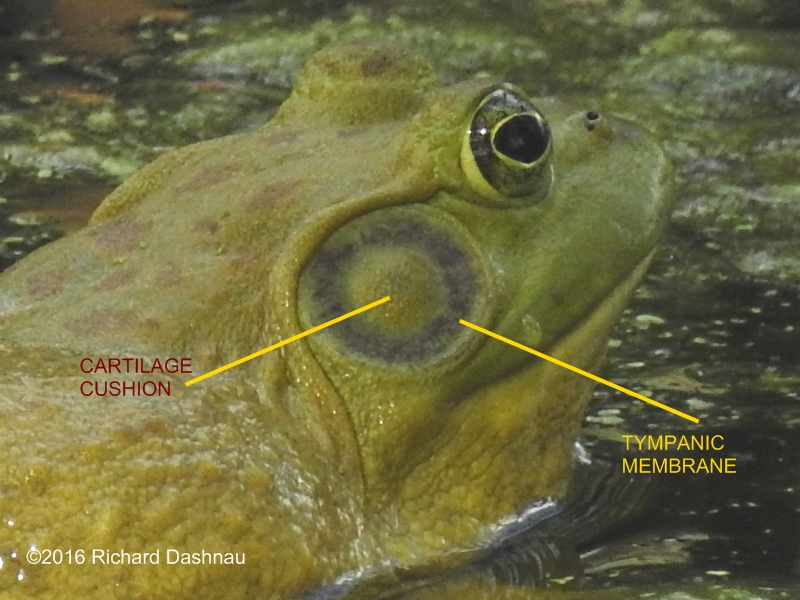
August 09, 2015
Bullfrogs are active around the park, although they were not calling
this morning as they have been over the last few weekends. While I was
walking West on the Spillway trail
(on my way back to the Nature
Center to work a shift) I noticed one Bullfrog seemed to be watching
something. It's hard to explain why this frog caught my attention, but I knew
that
something was up. This could be partly due to my experiences with the
Bullfrog I'd kept as a pet for quite a while long ago. I used to watch
it hunt in its terrarium home.
Anyway, I had just enough time to
start filming him with high-speed video. I didn't want to move closer
and possibly scare him, so I stayed back where I was.
The sequence of pictures below are frames from the video clip. The video clip (filmed at 210 FPS) is here (wmv). I shot the RICKUBISCAM closeup as a photo with
a different camera.
The
gender of a Bullfrog can be determined by looking at its ear membrane
(the circle just behind the eye). If it is smaller-or about the size
of the eye, then the frog is female. If the
ear is larger than the eye (usually much larger--as in the picture), then the frog is a male--at least for Bullfrogs.
Bullfrogs
will eat anything they can catch and cram down their throat. This can
be worms, insects, crawfish, even smaller frogs. In this case, the prey
seemed to be a fuzzy, white caterpillar.
I'd thought I might be
able to identify it later, but there are MANY "fuzzy white
caterpillars". I was happy to be able to catch this frog's leap and
slow it down.
IMAGE SEQUENCE OF THE FROG'S LEAP:
 --
-- -
- --
--
It's not usually obvious, but frogs can
turn their heads. This head-turning is what caught my attention. As
the frog focused on its prey, it turned its body ("aimed" its body) by
shifting position of its rear legs. With the prey properly in its sights, the frog "fired" by jumping.
 --
-- -
- --
--
Now
an amphibian missile, the frog flew towards its target. Note the front
legs tucked in close to the body. Imagine having to eat by launching
yourself, FACE FIRST-at high speed-at
your food. Also consider that this food is alive, and would fight back if it could.
 --
-- -
- --
--
TONGUE GRAB!
Just
before reaching its target, the frog launched its tongue. What amazing
timing this must take! The airborne frog, launched fast enough to fly
horizontally, launched its
tongue with enough time to pull it and prey back into its mouth before hitting the water.
A Bullfrog's tongue is attached near the front of
it's lower jaw (not near the back, as ours is). Therefore the tongue
(which is sticky) flips out, snags prey, and flips it back
towards
the frog's throat. In the second picture above (TONGUE GRAB!), the
tongue shows as the pinkish spot just in front of the frog.
 --
-- -
- --
--
Then
the belly-flop landing. With the prey having been caught, stealth is
no longer needed-although this kind of commotion can draw the attention
of competing male frogs or
...predators of frogs. The front legs have extended, also, and are sometimes used to push struggling prey into its mouth.
01/04/2009--Slow-Motion
clip of a Bullfrog leaping out of frame at BBSP. The video could
have been better, but it still shows some interesting things. The frog
expelled a string of large droplets near the top of its leap.
It
seems to me that the droplets striking the water could be a form of
visual (and aural) distraction. Since the stream hits within the flight
path of the frog, watching eyes would be drawn to these splashes, while
the camouflaged
frog could be lost from view. Click this link for the video.
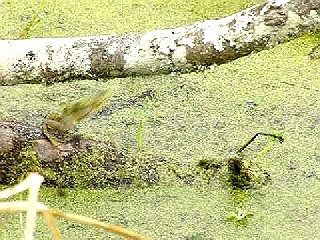
08/06/2006--Finally,
there is one more clip
4840 wmv . This is of a bullfrog calling, and the little "poot!" noise
that Bullfrogs make sometimes after a bout of calling. ------------------------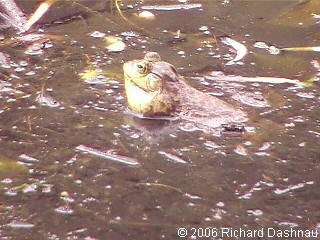 -
-
HI DIDDLE DIDDLE AMPHIBIAN BULL FIDDLE
VIDEO CLIP 4840 kb wmv
A large
number of Bullfrogs can be heard in the clip. It is illegal to catch or
molest any animal (with the exception of fish) at BBSP. Frogs cannot be
legally caught IN ANY WAY at BBSP. Although fishing is
allowed, State fishing regulations must be followed.
Leave
the animals you see at BBSP alone, so that other visitors may enjoy seeing
them (and also to avoid being ticketed and fined).
April
27, 2003I
have one more clip to answer a question that many visitors have asked.
They keep asking what this loud "jug-o-rum" sound is. The culprit
is the Bullfrog (rana catesbeiana). I've finally been able to get one on
video as it's calling(see WHERE'S THE BEER?, below; or see the clip
flv video
308 kb ) . Listen to this, and compare to the various alligator bellows
on my pages.
------------------------------------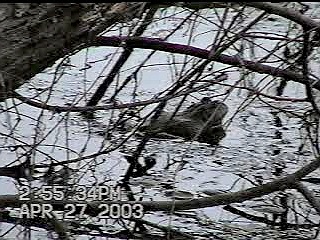 ----------------------
----------------------
---------------------------WHERE'S
THE BEER?
If you'd like to know more about the park follow these links:
Brazos
Bend State Park The main page.
Brazos
Bend State Park Volunteer's Page The
volunteer's main page.
Go back to my home page, Welcome
to rickubis.com
Go
back to the RICKUBISCAM page.
Go
back to the See the World
page.
























